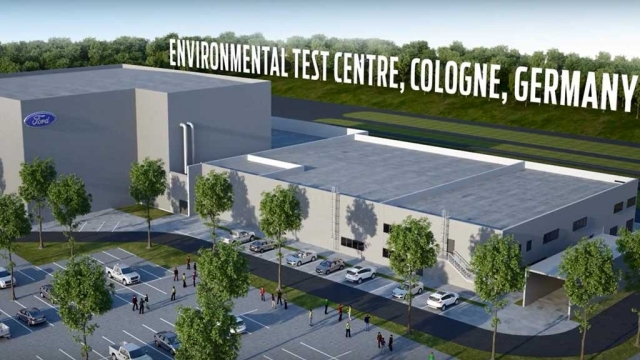
Ford’s new Weather Factory is ground zero for testing vehicles in the most demanding weather conditions around the globe. Image Courtesy of Ford
Latest News
December 30, 2016
Ford, known for its muscular cars and trucks, is putting some serious horsepower into its testing practices to ensure its global vehicle line can operate in extreme weather conditions in any geographic location across the globe.
The new Ford “Weather Factory,” to be based in Cologne, Germany, will be unlike any other Ford testing facility in that it will allow engineers to choose a weather pattern representing the most demanding conditions found around the world to put its vehicle designs through their paces. The automotive environmental test center, which Ford is touting as the most advanced its kind, will cover an area of 5,500 square meters and include an array of state-of-the-art technology that will give engineers a wide berth in their physical testing practices.
For example, the new test facility is home to a pair of climate wind tunnels, a high-altitude lab and four temperature controlled test chambers, three of which will also facilitate humidity testing. This tech-enabled test facility will allow Ford engineering teams to simulate how a vehicle would perform in altitudes higher than the tallest Alpine peak or in the midst of wind speeds of up to 250 km/h (or 155 mph). The facility is also capable of simulating snow, glaring sunlight and wind-swept rain.
 Ford’s new Weather Factory is ground zero for testing vehicles in the most demanding weather conditions around the globe. Image Courtesy of Ford.
Ford’s new Weather Factory is ground zero for testing vehicles in the most demanding weather conditions around the globe. Image Courtesy of Ford.Temperature swings are another parameter that can be easily tested in the new facility. The Weather Factory lets engineers simulate extremes temperatures on both ends of the spectrum for their vehicle test beds—from -40° Celsius (-40°F), the average winter temperature in Siberia, up to +55° Celsius (131°F), which is just below the highest temperature ever recorded. The factory is also configured to simulate high levels of humidity—up to 95%.
Ford is touting the new facility, slated to open in 2017, as a versatile testing toolkit that will help its engineering groups continue to develop future, best-in-class vehicles, company officials said. For example, engineers could put a Ford Focus through a battery of tests that would explore how the heating system and window defrost capabilities would operate under extreme cold and blizzard conditions or to evaluate the impact of snow on a passenger’s ability to open a door.
Engineers will be able to work on up to nine different vehicles simultaneously at the center, so different test beds could be run to evaluate how a particular vehicle design stands up to comfort, safety and operational performance under varying weather conditions.
The Cologne Weather Factory is one of a number of physical test facilities used by Ford as part of its vehicle development programs. Some of its early autonomous vehicle work is being explored at Mcity, a full-scale simulated real-world city environment at the University of Michigan. The auto giant also maintains a test track in Belgium, where it conducts pothole testing, side-wind tests, and saltwater and mud bath testing.
In addition to its rigorous physical testing efforts, Ford maintains a robust computer-aided engineering (CAE) program to perform vehicle design simulation continuously throughout the development process. In addition, the auto giant has actively engaged virtual reality technology to help speed up the design process and create virtual prototypes to minimize reliance on physical models.
Watch this video to learn more about Ford’s upcoming Weather Factory facility.
https://youtu.be/2zMrnXXsb6w
Subscribe to our FREE magazine, FREE email newsletters or both!
Latest News
About the Author
Beth Stackpole is a contributing editor to Digital Engineering. Send e-mail about this article to [email protected].
Follow DERelated Topics






